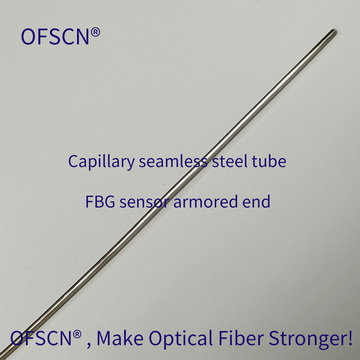The marine industry has long relied on oil and gas exploration on the seabed to meet the world's energy demands. However, the harsh environment of the seabed poses significant challenges for exploration, and traditional techniques are often unable to provide the necessary data to locate and extract oil and gas reserves efficiently. Fiber grating sensing technology has emerged as a valuable tool for subsea exploration in recent years, offering reliable and accurate data collection in a variety of challenging underwater environments. In this article, we will discuss the problems that fiber grating sensing technology can solve, and how Beijing Dacheng Yongsheng Technology Co., Ltd.(short for DCYS ) can support the oil and gas exploration on the seabed in marine industry.
Fiber Bragg Grating Sensing Principle:
Fiber Bragg gratings (FBGs) are periodic structures that are inscribed in the core of an optical fiber. These structures reflect a specific wavelength of light that is determined by the periodicity of the grating. When the grating is subjected to mechanical or thermal strain, the reflected wavelength changes in a predictable manner. By monitoring the reflected wavelength, changes in strain, temperature, and other parameters can be detected. FBG sensors can be used to monitor a wide range of parameters, including strain, stress, temperature, and vibration.
Click the link below for more details:
Demand analysis for the Subsea Oil and Gas Exploration:
The demand for subsea oil and gas exploration in the marine industry is driven by the world's ever-increasing energy needs. As land-based oil and gas reserves become depleted, the industry has turned to the seabed to find new sources of energy. However, the subsea environment presents significant challenges for exploration, including high pressures, corrosive seawater, and extreme temperatures.
Why Exploration for Subsea Oil and Gas is Needed:
The exploration for subsea oil and gas is critical to meeting the world's energy needs. The reserves located on the seabed are vast and are estimated to contain a significant portion of the world's undiscovered oil and gas reserves. Moreover, the development of subsea exploration techniques has enabled the industry to access reserves in increasingly deeper waters, further expanding the world's energy supply.

Difficulties in Subsea Oil and Gas Exploration in the Marine Industry:
The harsh environment of the seabed presents significant challenges for subsea oil and gas exploration. The high pressures, corrosive seawater, and extreme temperatures can damage equipment and interfere with data collection. Traditional techniques, such as seismology and drilling, are often unable to provide the necessary data to locate and extract oil and gas reserves efficiently.

What Problems can be Solved by FBG Sensing Technology:
Fiber grating sensing technology offers several advantages for subsea oil and gas exploration. It can operate in harsh environments, including high pressures and extreme temperatures, making it ideal for use in subsea applications. Fiber grating sensors can detect small changes in strain, temperature, and other stimuli, providing valuable data for locating and extracting oil and gas reserves. Furthermore, fiber grating sensors are small and lightweight, making them easy to deploy and maintain in the subsea environment.
Recommended fiber grating temperature, strain, stress, displacement, vibration, and shape sensors:
Fiber Bragg Grating Stress Sensor - FBG Stress Gauge - Bolt and Anchor Rod Stress Detection
Beijing Dacheng Yongsheng Technology Co., Ltd.:
Beijing Dacheng Yongsheng Technology Co., Ltd.(short for DCYS) is a professional manufacturer of fiber grating sensors, fiber grating demodulators and system software. Specializing in the production of various fiber grating sensors, including temperature, strain, stress, displacement, vibration, shape sensors, etc. DCYS also produces fiber grating demodulators, and can customize and develop related application software.
Recommended fiber grating demodulator:
Product Alias: Fiber Bragg Grating Interrogator, FBG Interrogator, FBG Sensor Interrogator, Fiber Optic Grating Interrogator, Fiber Bragg Grating Demodulator, FBG Demodulator, Fiber Optic Grating Demodulator
This product is produced by DCYS, and it is a high-speed high-frequency fiber Bragg grating demodulator(Interrogator). The fiber grating demodulator is compatible with various specifications and models of OFSCN® fiber bragg grating sensors (temperature, strain, stress FBG sensors, etc.). It features adjustable port density (4, 8, 16 channels) and high-speed high-refresh rate capabilities.
DCYS Helps to Explore the Oil and Gas on the Seabed:
DCYS can help solve some problems in the exploration of seabed oil and natural gas in the marine industry. DCYS's fiber grating sensors offer reliable and accurate data collection in a variety of challenging underwater environments. Additionally, DCYS can work with clients to develop custom solutions that meet their specific needs.

Other Points Need to Be Clarified:
In conclusion, fiber grating sensing technology plays an important role in the marine industry for various applications, including structural health monitoring of underwater pipelines, offshore oil drilling platforms, and subsea oil and gas exploration. By leveraging the advantages of fiber grating sensors, such as high sensitivity, accuracy, reliability, and durability, many of the challenges and limitations in these applications can be overcome. With the help of Beijing Dacheng Yongsheng Technology Co., Ltd., which specializes in fiber grating sensing technology and provides customized solutions and support, the marine industry can benefit from the increased efficiency, safety, and profitability that these advanced technologies can offer.
